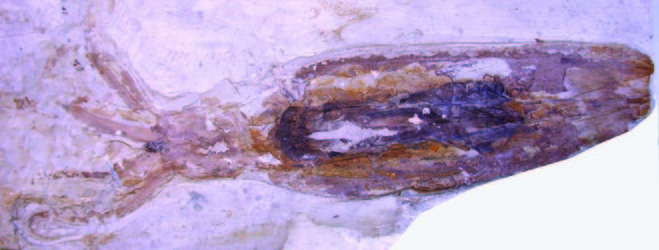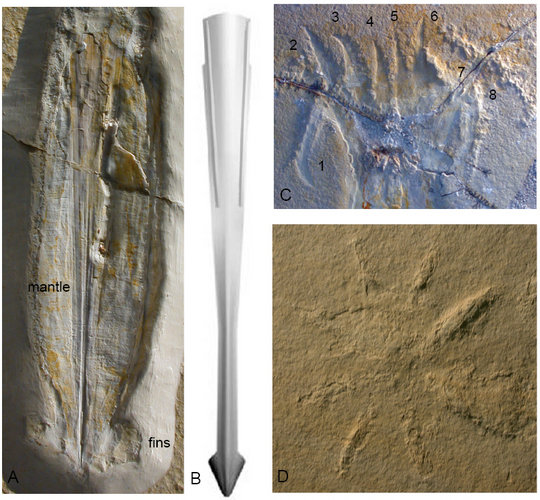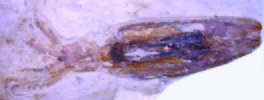Prototeuthidina
Plesioteuthididae 
Dirk Fuchs
- Paraplesioteuthis Naef, 1921

- Romaniteuthis Fischer & Riou, 1982

- Romboteuthis Fischer & Riou, 1982

- Plesioteuthis Wagner, 1859

- Senefelderiteuthis Engeser & Keupp, 1999

- Dorateuthis Woodward, 1883

- Nesisoteuthis Doguzhaeva, 2005

- Boreopeltis Engeser & Reitner, 1985

Introduction
The Prototeuthidina is a well-known group of gladius-bearing coleoids that probably appeared at the end of the Triassic period and disappeared during the latest Cretaceous. Its gladius and hence its mantle is very slender when compared with the other two subgroups. The prototeuthidid gladius is furthermore characterized by a ventrally close (funnel-like) conus.
Figure: Plesioteuthis prisca, Tithonian (late Jurassic), Solnhofen area (Germany). A) specimen in dorsal view preserved with gladius, mantle and fins, B) reconstruction of the gladius, C) imprints of an arm crown consisting of 8 arms, D) star-like arm imprints produced when the dead animal landed on the sea floor in an oral-end-down position. © Dirk Fuchs
Particularly late Jurassic Plesioteuthis prisca is in the focus of debates as its gladius superficially resembles an ommastrephid gladius. Since Plesioteuthis prisca and other prototeuthidids such as late Jurassic Senefelderiteuthis tricarinata or late Cretaceous Dorateuthis syriaca never show more than eight arms, Fuchs (2006a, b) and Fuchs et al. (2007b) regarded the Prototeuthidina as an extinct side branch of early Octopodiformes.


Figure: Head and arm crown of Dorateuthis syriaca from the Cenomanian (late Cretaceous) of Hakel (Lebanon). © Dirk Fuchs
Characteristics
1. Gladius- conus ventrally closed (funnel-like)
- median field comparatively slender, triangular (anterior margin more or less straight), with median and lateral reinforcements
- hyperbolar zones reduced or absent
- lateral fields comparatively short, in most cases less than the half median field length.
Classification
Classification of Prototeuthidina Naef, 1921
- Plesioteuthididae Naef, 1921
- Paraplesioteuthis Naef, 1921 (Toarcian)
- Paraplesioteuthis sagittata (Münster, 1843) **
- Romaniteuthis Fischer & Riou, 1982 (Callovian)
- Romaniteuthis gevreyi (Roman, 1928)*
- Romboteuthis Fischer & Riou, 1982 (Callovian)
- Romboteuthis lehmanni Fischer & Riou, 1982*
- Plesioteuthis Wagner, 1859 (Tithonian)
- Plesioteuthis prisca (Rüppell, 1829)****
- Plesioteuthis subovata (Münster, 1846)*
- Senefelderiteuthis Engeser & Keupp, 1999
- Senefelderiteuthis tricarinata (Münster, 1846)**
- Dorateuthis Woodward, 1883 (Tithonian - Santonian)
- Dorateuthis syriaca Woodward, 1883****
- Nesisoteuthis Doguzhaeva, 2005 (Aptian)
- Nesisoteuthis simbirskensis Doguzhaeva, 2005*
- Boreopeltis Engeser & Reitner, 1985 (Tithonian - Cenomanian)
- Boreopeltis sagittata (Naef, 1921)*
- Boreopeltis helgolandiae Engeser & Reitner, 1985*
- Boreopeltis sp.*
- Boreopeltis soniae Wade, 1993**
- Paraplesioteuthis Naef, 1921 (Toarcian)
(* only one specimen known; ** 2-5 specimens; *** 5-10 specimens; **** > 10 specimens)
Problematic or poorly known prototeuthidids
- “Loligosepia“ neidernachensis Reitner, 1978 (Triassic, Rhaetian)*
- “Plesioteuthis” arcuata von der Marck, 1873*
- “A.“ maestrichtensis Binkhorst v. Binkhorst, 1861*
- “Neololigosepia stahleckeri” Reitner & Engeser, 1982*
- “Plesioteuthis?” Hecker & Hecker, 1955*
- “Maioteuthis” damesi Engeser & Reitner, 1985*
- Plesioteuthis sp. Engeser & Reitner, 1985*
- “Maioteuthis” morroensis Reitner & Engeser, 1982*
References
Fuchs, D. 2006a. Fossil erhaltungsfähige Merkmalskomplexe der Coleoidea (Cephalopoda) und ihre phylogenetische Bedeutung. Berliner Paläobiologische Abhandlungen 8: 1-115.
Fuchs, D. 2006b. Diversity, Taxonomy and Morphology of vampyropod Coleoids (Cephalopoda) from the Upper Cretaceous of Lebanon. Memorie della Società Italiana di Scienze Naturali et del Museo Civico di Storia Naturale di Milano 34(II): 1-28.
Fuchs, D., Klinghammer, A., & Keupp, H. 2007b. Taxonomy, morphology and phylogeny of plesioteuthidid coleoids from the Upper Jurassic (Tithonian) Plattenkalks of Solnhofen. Neues Jahrbuch für Geologie und Paläontologie, Abhandlungen 245(2): 239-252.
Title Illustrations

| Scientific Name | Dorateuthis syrica |
|---|---|
| Specimen Condition | Fossil -- Period: Cenomanian (Late Cretaceous), Hadjoula (Lebanon) |
| Identified By | D. Fuchs |
| Image Use |
 This media file is licensed under the Creative Commons Attribution-NonCommercial License - Version 3.0. This media file is licensed under the Creative Commons Attribution-NonCommercial License - Version 3.0.
|
| Copyright |
© Dirk Fuchs

|
About This Page
Dirk Fuchs

Hokkaido University
Correspondence regarding this page should be directed to Dirk Fuchs at
Page copyright © 2015 Dirk Fuchs
 Page: Tree of Life
Prototeuthidina. Plesioteuthididae .
Authored by
Dirk Fuchs.
The TEXT of this page is licensed under the
Creative Commons Attribution-NonCommercial License - Version 3.0. Note that images and other media
featured on this page are each governed by their own license, and they may or may not be available
for reuse. Click on an image or a media link to access the media data window, which provides the
relevant licensing information. For the general terms and conditions of ToL material reuse and
redistribution, please see the Tree of Life Copyright
Policies.
Page: Tree of Life
Prototeuthidina. Plesioteuthididae .
Authored by
Dirk Fuchs.
The TEXT of this page is licensed under the
Creative Commons Attribution-NonCommercial License - Version 3.0. Note that images and other media
featured on this page are each governed by their own license, and they may or may not be available
for reuse. Click on an image or a media link to access the media data window, which provides the
relevant licensing information. For the general terms and conditions of ToL material reuse and
redistribution, please see the Tree of Life Copyright
Policies.
- First online 03 May 2010
- Content changed 03 May 2010
Citing this page:
Fuchs, Dirk. 2010. Prototeuthidina. Plesioteuthididae . Version 03 May 2010 (under construction). http://tolweb.org/Plesioteuthididae/140239/2010.05.03 in The Tree of Life Web Project, http://tolweb.org/









 Go to quick links
Go to quick search
Go to navigation for this section of the ToL site
Go to detailed links for the ToL site
Go to quick links
Go to quick search
Go to navigation for this section of the ToL site
Go to detailed links for the ToL site